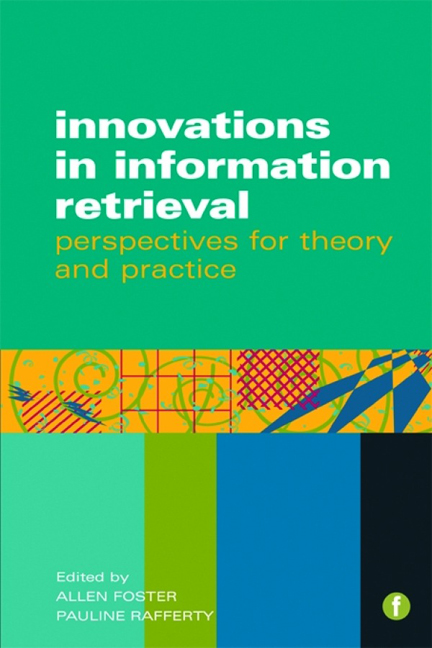Book contents
- Frontmatter
- Contents
- Figures and tables
- Contributors
- Foreword
- Introduction
- 1 Encountering on the road to Serendip? Browsing in new information environments
- 2 Classification revisited: a web of knowledge
- 3 Approaches to fiction retrieval research: from theory to practice?
- 4 Music information retrieval research
- 5 Folksonomies, social tagging and information retrieval
- 6 Digital information interaction as semantic navigation
- 7 Assessing web search engines: a webometric approach
- Index
6 - Digital information interaction as semantic navigation
Published online by Cambridge University Press: 08 June 2018
- Frontmatter
- Contents
- Figures and tables
- Contributors
- Foreword
- Introduction
- 1 Encountering on the road to Serendip? Browsing in new information environments
- 2 Classification revisited: a web of knowledge
- 3 Approaches to fiction retrieval research: from theory to practice?
- 4 Music information retrieval research
- 5 Folksonomies, social tagging and information retrieval
- 6 Digital information interaction as semantic navigation
- 7 Assessing web search engines: a webometric approach
- Index
Summary
Introduction
In this chapter we focus on the research area of digital information interaction, which emphasizes searchers’ direct engagement with and manipulation of information objects as they search and browse through digital information environments. This is an area of active research that has opened up in recent years as information retrieval (IR) research has expanded its focus from the mechanics of retrieval (i.e. indexing, data structures and retrieval algorithms) to include a broader ‘retrieval in context’ perspective that takes into account the whole system, the affective, cognitive and physical attributes of users and the environment in which searching takes place (Ingwersen and Jarvelin, 2005). A number of meetings and workshops have focused on this area, including the Information Retrieval in Context (IRiX) workshops at the ACM SIGIR (Association for Computing Machinery Special Interest Group Information Retrieval) conference (2004–5), the Information Interaction in Context (IIiX) Conference (2006–ongoing) and the Human Computer Information Retrieval (HCIR) Workshops (2007–ongoing).
Immersive information systems, in which users are placed in content-rich environments with tools and technologies designed to help them search, filter and navigate through the information landscape, are now commonplace. In these types of environments, IR can no longer best be modelled as a transaction, but is more akin to an ‘experience’, in which searchers are influenced by the information objects they encounter and also shape and create their information environment by selecting, linking, tagging and commenting (Marchionini, 2008; Toms, 2002). For many people, these kinds of interactions with digital information are the primary means by which they read and learn, whether at work, at school or at leisure.
However, numerous studies that utilize server logs of bibliographic and web based information systems have shown that digital information behaviour is markedly different from that in traditional print information environments. Digital information use tends to be non-linear, shallow and piecemeal. Readers jump frequently from one document to the next, ‘skimming and bopping’ through networked information spaces (JISC, 2008; Nicholas et al., 2007). Concerns have been raised that this type of information behaviour represents the ‘intellectual equivalent of empty calories’ (Rich, 2008) and inhibits deep, critical engagement with informational content (Marshall, 2005).
- Type
- Chapter
- Information
- Innovations in Information RetrievalPerspectives for theory and practice, pp. 117 - 134Publisher: FacetPrint publication year: 2011
- 1
- Cited by



